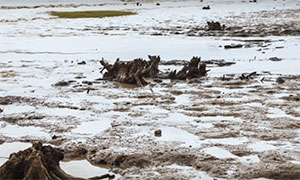|
The MAP News
484th Edition Dec 21, 2019 |
|
FEATURE Brighten someone's new year with a Childrens Art calendar from MAP  Our 2020 Calendar is a great way to give someone a daily reminder of the future of our planet and it's most precious asset – our children. This beautiful calendar features art from children around the world expressing the knowledge they learned as they studied mangroves and their impact in their lives. Support MAP to showcase this important effort to raise global awareness of these critical forest habitats. Order one foryourself or as a gift to afriend. Volume discounts available on orders of 4 or more. Prices shown include shipping, so be sure to indicate if you want US domestic shipping or international shipping. You can also help by signing up to sponsor the next calendar's producyiona and shipping cost. Click Here for Details on Ordering and becoming a sponsor READ MORE 2nd FEATURE Dr. Jurgenne Honculada Primavera named Hatai Medal recipient for 2020  JAPAN - The Pacific Science Association has named Dr. Jurgenne Honculada Primavera the Hatai Medal in appreciation of her significant contribution to mangrove preservation. The Shinkishi Hatai Medal was established in 1966 by the Pacific Science Association (PSA) in honor of his leadership and contribution to science in the Pacific region. This prize awards scientists who have made great contribution to marine biology in the Pacific region. Since its establishment, the medal has been awarded every four years at the Pacific Science Congress. From the 13th award in 2016, Tohoku University took over the role of the Science Council of Japan and is taking part as the secretariat. Now the medal has the seals of the Pacific Science Association and Tohoku University. Ceremony to award the next Hatai medal will be held during the congress of the PSA in Shantou University (Guangdong Province, PRC / China) in 13-17 July 2020. Jurgenne Honculada-Primavera is a widely-cited Filipina marine scientist. For her research in mangrove ecosystem conservation she was honored as one of Time magazine's Heroes of the Environment for 2008. She was inducted into the National Academy of Science and Technology in 2015. READ MORE GLOBAL Our communities are risking their lives to defend our world  GLOBAL - Alongside the 8th UN Forum on Business and Human Rights in Geneva today, representatives from indigenous peoples, afro-descendent and peasant communities from 16 countries issued an urgent call for action – the Geneva Declaration. They are demanding governments and companies end the violence, killing and deliberate criminalisation of people defending their rights, their lands and their communities. ‘We wish to live free of violence and demand the respect for our lives and our rights! The government should not impose their visions of development on us.’ Indianara Ramires Machado, from Brazil’s Guarani-Kaiowà indigenous peoples, said today. Written by those who have seen first-hand what happens when destructive business activities are conducted with impunity at the expanding frontier of agricultural and extractive industries, the Declaration articulates the extreme challenges that they and their communities, families and peoples face. READ MORE Call to Action - Stop plundering the oceans for industrial aquaculture! 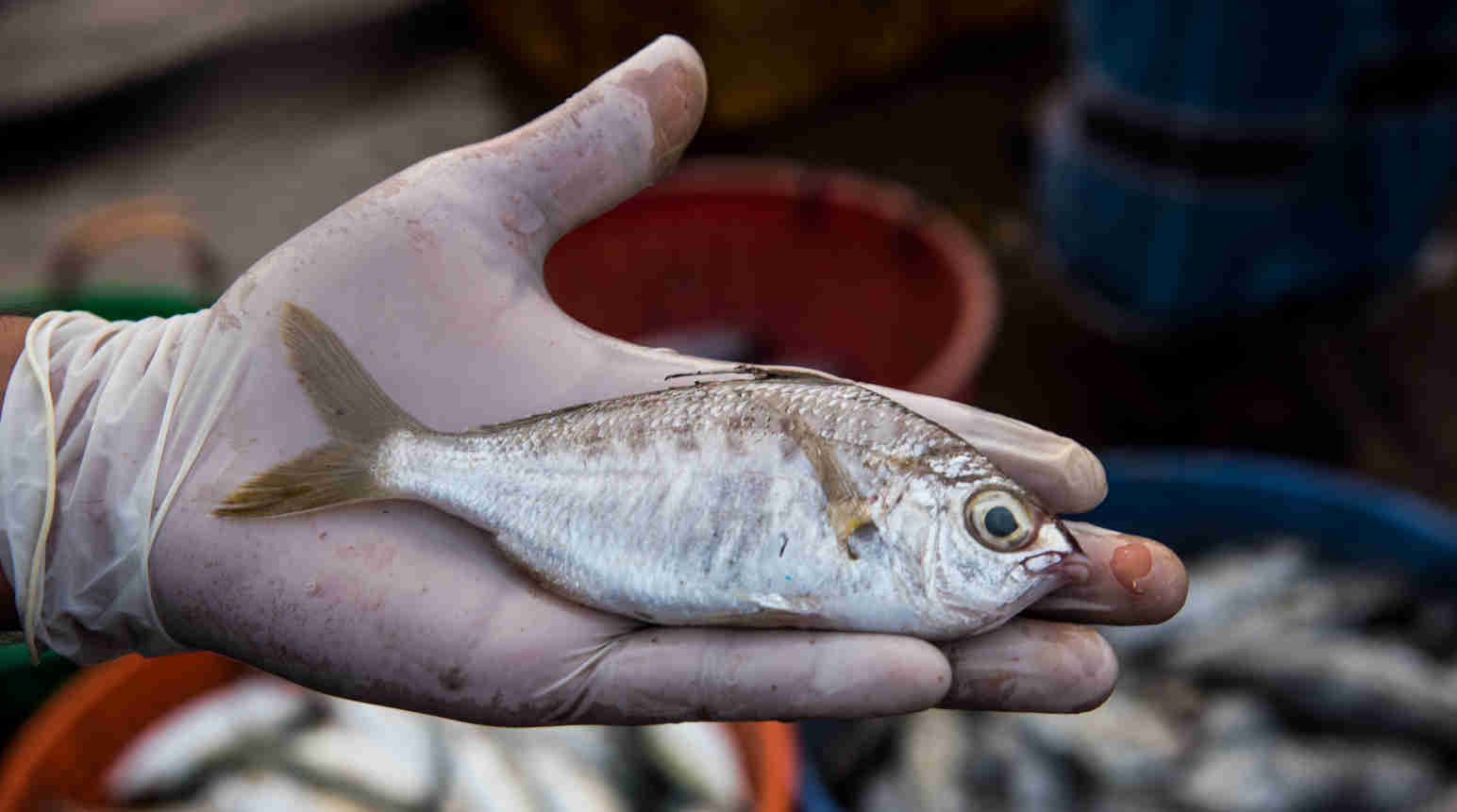 GLOBAL - Global seafood consumption has doubled over the past five decades. Every year, 80 million tons – almost half of the seafood on our plates – is produced by “aquaculture”: an industry that builds floating cages for salmon, artificial ponds for prawns on the coasts, and tanks for seafood in factory buildings – essentially, aquatic factory farms. But aquaculture is not the solution to overfishing that it is often touted to be – in fact, it is worsening the problem. Trawler fleets sweep up vast quantities of wild fish and grind them into fishmeal and fish oil to feed farmed fish. Far from being “sustainable”, this is an incredibly inefficient and wasteful process: it takes up to five kilos of edible fish such as anchovies, mackerels or sardines, for example, to produce a single kilo of salmon. More than two-thirds of the fish meal produced worldwide and three-quarters of the fish oil are now used as feed for farmed fish. READ MORE Tangled roots and changing tides GLOBAL - Within the last few decades, scientists have raised the alert on the continuous loss of mangrove forests. It is estimated that between 1980 and 2000, 35% of mangroves worldwide disappeared. This trend has not reversed and mangroves continue to face dramatic losses which is all the more alarming because mangroves provide essential services. For instance, they play a crucial role as coastal protection and carbon sinks in the battle against climate change thanks to their location between land and sea and high carbon storage capacity, 3-5 times higher than that of upland tropical forests. They also provide habitat to support fisheries, as well as fuel and construction material, fundamental to the livelihoods of over 120 million people coastal communities across the globe. To address these challenges, Save Our Mangroves Now!, an initiative by the German Federal Ministry for Economic Cooperation and Development (BMZ), WWF and IUCN, through the IUCN Environmental Law Centre worked with lawyers from seven countries to develop a comprehensive study detailing the legal and institutional frameworks affecting mangroves, and their impact on stakeholders’ behaviour and the natural environment. READ MORE AFRICA Yelibuya, the sinking Sierra Leone island town 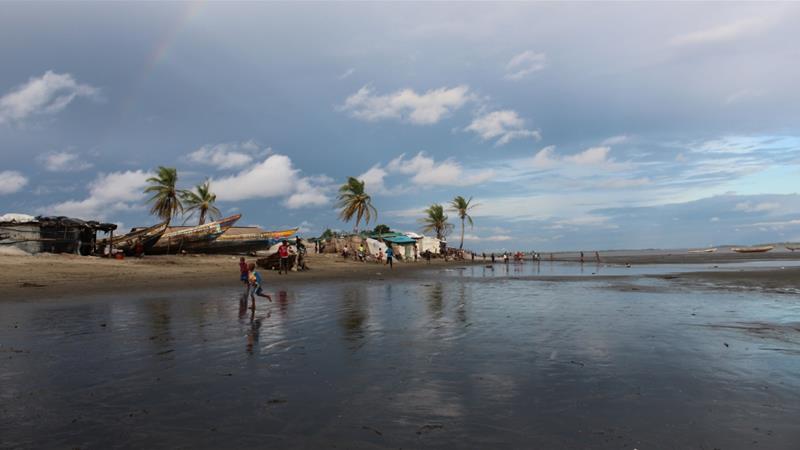 SIERRA LEONE - In the Northwest Sierra Leone’s island town of Yelibuya, some 5,000 people who live there are staring at mass displacement as the town slowly gets swallowed by one of the country’s largest rivers, the Great Scarcies, also christened Kolente, which drains into the Atlantic Ocean. Mangroves have acted as buffers between the island and river. These are a set of trees and shrubs that offer a critical ecosystem for fish and other aquatic life. But without electricity or alternative sources of energy, residents of Yelibuya have been relying on the mangroves for fuel and construction as their houses continue being swept away by the raging waters. This wanton destruction of the mangrove forests, climate change and the rising waters have contributed to the river further encroaching the inland. Despite there being no official statistics on the extent of this encroachment, community elders in the area say the waters have moved some 300 meters towards the town for the last 30 years. Now scientists insist that if the current situation persists the island will be submerged in the next two decades. READ MORE Are Nature Based Solutions the key to Africa’s climate response?  SEYCHELLES - While the UN climate talks are celebrating their 25th year, carbon emissions around the world have continued to climb. For many, that is where natural solutions could play a key role in managing a dramatic climate transition. Nature-based solutions or the process of working with and around natural ecosystems to deliver real-world benefits for climate resilience and sustainable development, took center stage on day 4 of COP25 in Madrid). Vanessa Ushie, Manager of the Policy Analysis Division at the Bank’s African Natural Resource Centre, briefed delegates at COP 25 about the Centre’s work during a panel discussion. “Nature-based solutions are easy to use, and very effective in improving community livelihoods and resilience to climate change. The AfDB is scaling up the use of nature-based solutions to address climate impacts on critical ecosystems and biodiversity in Africa,” Ushie said. “Through this program we have funded mangrove restoration and climate education programmes,” said Angelique Pouponneau, who runs a Seychelles-based trust fund focusing on climate adaptation and conservation.READ MORE AMERICAS Hurricanes Hit Puerto Rico’s Mangroves Harder Than Florida’s 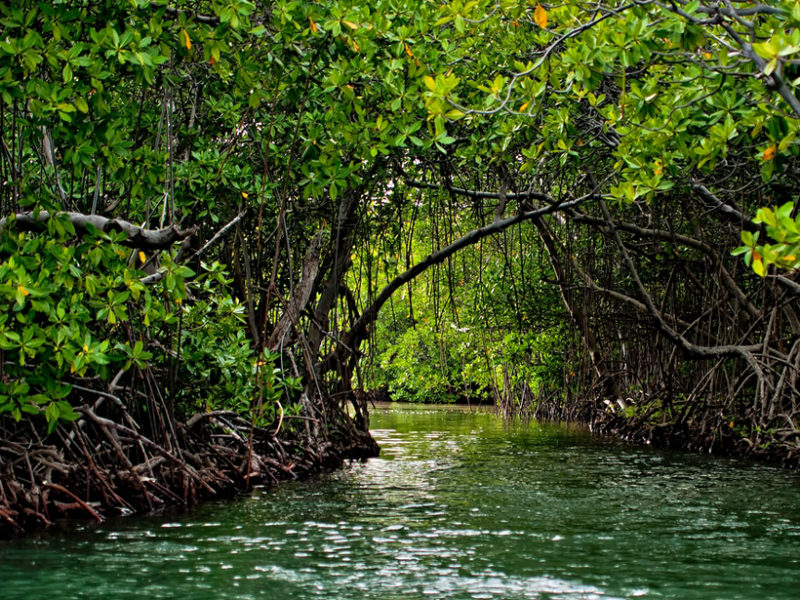 Puerto Rico’s mangrove forests sustained an average of 3 times more damage during Hurricane Maria than southern Florida’s mangrove forests did during Hurricane Irma. Both 2017 storms sheared the tops off mangrove trees in the regions’ coastal ecosystems, but Puerto Rico’s mangroves experienced a wider range of damage, possibly because of the island’s mountainous terrain. The forests “both saw higher damages as wind speed increased, but the magnitudes of those damages between Florida and Puerto Rico differ greatly,” said Vivian Griffey, lead researcher and a master’s student at the University of Washington in Seattle. “The degree to which those damages occur within the given wind speed classes differs between the different areas.” Not only did Puerto Rican mangroves lose more height on average, but there was also more variation in height loss in Puerto Rico than in Florida, she said. This variation got the researchers thinking that hurricane wind speed was not the only factor at play. Griffey presented this research recently at AGU’s Fall Meeting 2019 in San Francisco, Calif. READ MORE Let’s protect the mangroves and their taste  ECUADORE - Ecuador’s coastal city of Esmeraldas is home to a delicate ecosystem where endangered species risk losing their unique habitat, and by extension, the human population risks losing its food heritage. In a bid to mobilize the local Afro-Ecuadorian and Montubio communities to protect the region’s distinctive ecology and recognize its importance to the culture of Esmeraldas, a new Slow Food Presidium has been started. The project will involve a far-reaching collaboration between Slow Food and local small-scale producers in order to bolster the production of indigenous foods on the verge of extinction. This principle is at the heart of Slow Food Presidia, of which there are over 500 already active around the world today. “For me, eating food typical to our region means nourishing myself the same way parents did, and their parents before them. It speaks of traditions passed on down through the generations. As I eat a shell crab, ceviche or a corbiche, I realise that this is the richest inheritance I have received from my parents,” says Slow Food Presidium member Patricia Caicedo, whose mother dedicated herself to shell collecting and whose father worked as a palm grower. She is currently employed as a domestic worker in the northern part of the city. READ MORE ASIA Supertrees: Meet Indonesia’s carbon guardian /cdn.vox-cdn.com/uploads/chorus_image/image/65882721/GOPR8057.0.jpg) INDONESIA - Indonesia’s mangroves are an incredibly effective tool against climate change — but they’re being cut down to grow shrimp and palm oil for you. Novi Susetyo Adi is one of Indonesia’s top experts in coastal ecosystems: He studies the exquisite interconnections between mangroves, seagrass, and coral reefs. Inside mangroves, he’s tuned into the flurry of interactions between mud, water, gases, trees, and hundreds of other busy organisms. With colleagues at Indonesia’s Ministry of Marine Affairs and Fisheries, where he’s a research scientist, he’s both quantifying and preaching the benefits, or “ecosystem services,” of mangroves. The evidence, he hopes, will underlie new policies and laws that ensure the mangroves don’t disappear. With an estimated 17,500 islands and 34,000 miles of coastline, Indonesia lays claim to the most extensive mangroves on Earth — some 23 percent of the world’s total. Some of the trees are also among the world’s tallest mangroves, reaching 144 feet. Large-scale palm oil production is one of the biggest drivers of deforestation in Indonesia; tens of millions of acres of primary rainforest, peatlands, and coastal lowlands have been cleared to grow the oil-rich fruit for fuel, food, and household products for consumers around the world. (Take a look at the ingredients in your Trader Joe’s snacks and you might see palm oil — chances are it was not harvested sustainably.) Palm oil was also responsible for most of the fierce fires that burned more than 2,500 square miles in Indonesia this year; some 80 percent of the fires were set to clear land for the crop, officials told the New York Times. READ MORE |
CHILDREN'S ART CALENDAR - A great way to show your support for MAP. NOW TAKING ORDERS for our 2020 calendar
|
|
Mangrove Action Project Click here to view past newsletters
|
|
Search News Archive
Saturday, December 21, 2019
MAP NEWS Issue #484 - Dec 21, 2019
Saturday, December 7, 2019
MAP News Issue 483, Dec 07, 2019
|
The MAP News
483rd Edition Dec 07, 2019 |
|
FEATURE IMPACT: Afa Husayn protects a tropical paradise 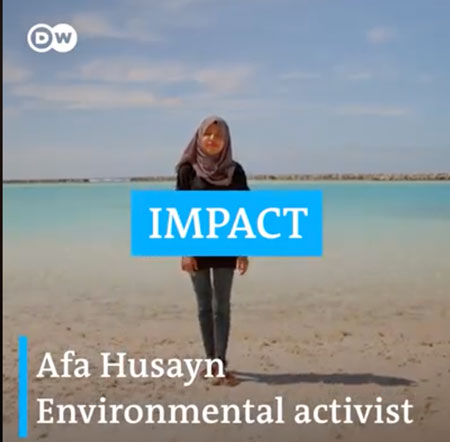 MALDIVES – We would be very happy to have a conversation to see how young environmental defenders in the Maldives can be helped to develop and establish themselves in this area, considering the climate vulnerability of the Maldives, our current climate crisis and the very much felt need among young people to engage effectively on this issue with stakeholders at all levels. Allow me to share this short video (above) by the German TV channel DW-TV, which produced a short video article on Afa Husayn from BeLeaf very recently. A short video on the broader issue is available at the link below, which features some of our other advocates.VIEW HERE GLOBAL 'Our communities are risking their lives to defend our world.' A global call to action to stop violence and killings in supply chains 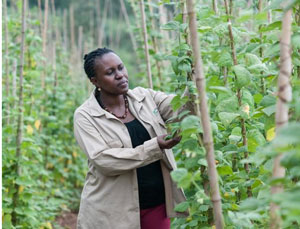 GLOBAL - Alongside the 8th UN Forum on Business and Human Rights in Geneva today, representatives from indigenous peoples, afro-descendent and peasant communities from 16 countries issued an urgent call for action – the Geneva Declaration. They are demanding governments and companies end the violence, killing and deliberate criminalisation of people defending their rights, their lands and their communities. ‘We wish to live free of violence and demand the respect for our lives and our rights! The government should not impose their visions of development on us.’ Indianara Ramires Machado, from Brazil’s Guarani-Kaiowà indigenous peoples, said today. Written by those who have seen first-hand what happens when destructive business activities are conducted with impunity at the expanding frontier of agricultural and extractive industries, the Declaration articulates the extreme challenges that they and their communities, families and peoples face. It offers practical recommendations for states, businesses, investors and others to ensure their rights are respected and protected. READ MORE Realizing the $1 trillion net benefit of protecting mangroves 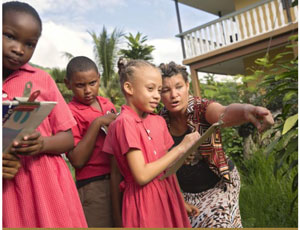 GLOBAL - A new report from the Global Commission on Adaptation outlines what the world stands to gain if it invests in mangroves, and other adaptation efforts, to mitigate climate change According to Act Now: A Global Call for Leadership on Climate Resilience, “investing $1.8 trillion globally in five areas from 2020 to 2030 could generate $7.1 trillion in total net benefits. The five areas we consider are early warning systems, climate-resilient infrastructure, improved dryland agriculture, mangrove protection, and investments in making water resources more resilient. This represents only a portion of the total investments needed and total benefits available.” As the world aims for ambitious climate targets, the Global Commission on Adaptation makes clear that mangroves are part of the solution. READ MORE AFRICA Group associations could save Mangrove forests  KENYA - A study done by the Kenya Forest service reveals that increased demand for mangrove wood products is due to increased population, weak governance, inadequate awareness of the actual value of mangrove ecosystems, plus unmonitored illegal activities. These have led to loss and transformations of mangrove forests. The Mida Creek-based group, alongside others in the neighbourhood, is working to reverse this trend by cultivating and planting mangrove seedlings. They also sell seedlings to other conservation-oriented organisations for replantation elsewhere. Collecting the seeds and planting them in seedbeds by the sea, guarantees that there will be regeneration. The youth reportedly produce approximately 20,000 seedlings annually. Mida creek, states Kenya Forestry Services (KFS) officer Elvis Katana Fondo, is the oldest reserve of its kind in the East Africa region. READ MORE More than twenty years of evolution of Madagascar's mangroves MADAGASCAR - This study was conducted by Save our mangroves now! It is an international initiative that mobilizes policy makers and supports environmental actors to stop and reverse the loss of mangroves. Save our mangroves now! has a particular focus in the Western Indian Ocean, which includes Madagascar. The WWF, the German Federal Ministry for Economic Cooperation (BMZ) and Development and IUCN are the leaders of this initiative and the authors of this cartography, available for download here. Based on cartographic analyzes and aerial photographs, the results of this study are about the evolution of Madagascar’s mangroves from 1995 to 2018. What we learn from these scientific analyzes? For the most part, mangroves are declining everywhere in Madagascar! The total surface of mangroves decreased from 294,387 ha in 2000 to just over 236,400 ha in 2018. Nevertheless, mangroves near marine or terrestrial protected areas are less impacted than others. Another important finding is that although the loss rates decreased over the years, the degradation increased. So, the degradation is the hidden loss. Also, and this is a milestone to this study, most of the areas where mangrove forests are managed by local communities are better in the whole country.READ MORE AMERICAS Mangrove forests in Colombia helping climate mitigation 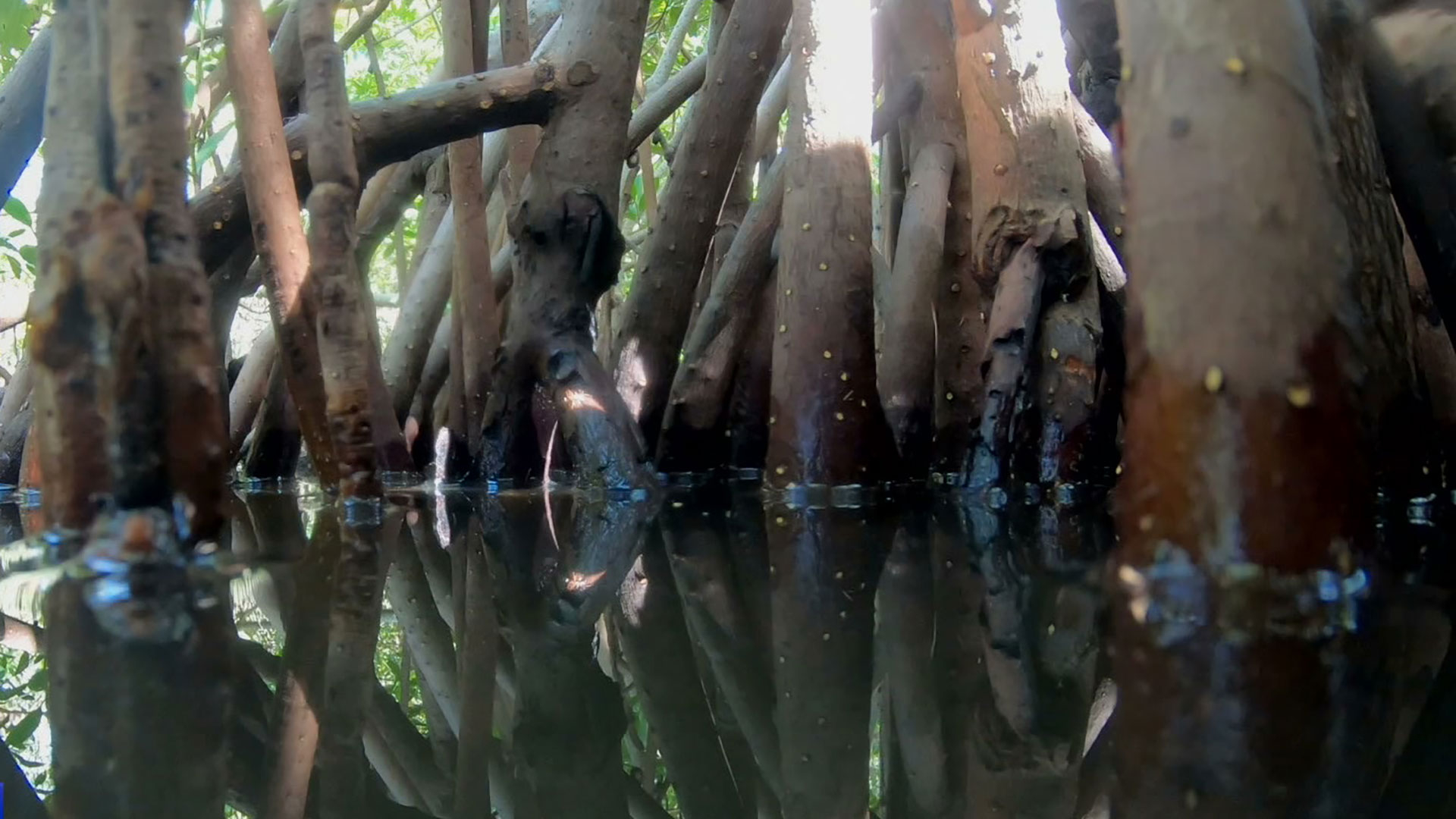 COLUMBIA - angrove forests, once linked to disease and insect pests, has now emerged as key ally in mitigating the effects of climate change like natural disasters. Colombian scientist Paula Sierra explains, "It provides a first line of defense along the coast. As you can see all of these roots, it can dissipate a wave. So when you have a mangrove along the coast and you have a strong current, the current hits the roots and the energy of the wave dissolves." Recent studies are showing mangroves role in climate mitigation goes even further. According to U.S.- based Conservation International, mangroves can store up to 10 times more carbon than land-based forests. They key is keeping them healthy. In a healthy mangrove, the carbon is trapped and locked away in the soil down below. However, in a mangrove that is destroyed, that carbon dioxide is released and that is what contributes to global climate change. For almost a decade, Colombia's Investigative Institute for Marine and Coastal systems – Invemar- has been studying these healthy Colombian mangroves. READ MORE Retired Texas shrimper wins record-breaking $50 million settlement /https://static.texastribune.org/media/files/8ceb6aabbdb46a71b0a891a7e3f898e2/05_Formosa_Plastic_Pollution_EW.jpg) TEXAS - U.S. District Judge Kenneth M. Hoyt approved the settlement agreement between a scrappy environmental coalition and plastics giant Formosa. The settlement is the largest in U.S. history resulting from a citizen environmental suit. A federal judge approved a historic settlement agreement Tuesday between Taiwan-based plastics manufacturer Formosa and a scrappy environmental activist represented by indigent legal services nonprofit Texas Rio Grande Legal Aid. TRLA said the $50 million settlement is the largest in U.S. history involving a private citizen's lawsuit against an industrial polluter under federal clean air and water laws. The money will be poured into a trust over the next five years and used to pay for programs supporting pollution mitigation, habitat restoration, public education and other environmental efforts on the middle Texas Gulf Coast. Diane Wilson, a retired shrimper and an environmental activist, sued Formosa in July 2017, alleging that its Port Comfort plant had illegally discharged thousands of plastic pellets and other pollutants into Lavaca Bay and other nearby waterways. READ MORE Mangroves, vital to many coastlines, are under threat  USA - Some mangroves are invasive, but many are vital coastline protectors. Their dense, firmly anchored root systems keep erosion from occurring during storms, and they filter water and provide shelter for marine life and other animals. The greenbelts also sequester carbon — the world’s mangroves sequester 75 billion pounds of carbon a year. But mangroves present plenty of worries. The plants are disappearing quickly because of human development, and over a quarter of Earth’s original mangrove forests have now been lost. Rising sea levels kill off mangroves — and as the climate changes and sea levels rise even more, losses could increase. Mangroves are considered a harbinger of climate change: As waters warm around the world, their habitat is shifting northward. That might bring more carbon sequestration and increasing shoreline protection. But rising waters have decreased the plants’ genetic diversity — and that could kill off mangroves as the planet warms. READ MORE ASIA Mass tree-planting projects go awry around the world 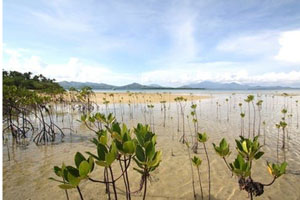 PHILIPPINES - From the Amazon to the Australian outback, the world’s forests are on fire. But just as all these trees disappear, politicians are sprouting promises to plant more of them like the dawning of a global spring. In the run-up to the UK election on December 12, Labour says it will plant two billion new trees on British soil by 2040 – that’s 100m a year. The Conservatives are pledged to 30m a year, while the Liberal Democrats say 60m. Perhaps the strangest efflorescence is Nigel Farage’s promise to persuade Donald Trump to lead a global afforestation campaign. These tree-planting pledges are certainly a step in the right direction, but there’s a problem. Everything being said is big on rhetoric but light on practicalities. As I know from many years of being involved with mangrove afforestation in the tropics, it’s a lot easier to plant seeds than it is to grow trees. So what lessons does the UK’s next government need to learn before it sends planters all over the countryside? READ MORE Rising Sea Levels And Disappearing Mangrove Forests Spell Trouble For Vietnam  VIETNAM - In Vietnam, the mangroves guard against dangerous salt water intrusions into farm land in the southernmost part of the Mekong Delta and also provide protection for a variety of wildlife. As Delta ecologist Nguyen Huu Thien explains, the Delta is the main food basket of Vietnam. It produces more than 50 percent of the country’s food, 90 percent of its rice exports, 65 percent of its fruit, and 75 percent of its fish, which are a major source of protein. The Delta still suffers from the impact of an ill-advised attempt by the Communist authorities after they took power in South Vietnam in the spring of 1975 to increase rice production there. In order to expand the space for rice production, the new rulers encouraged the destruction of the mangrove forests which had acted as a buffer to protect farm land from sea-driven salt intrusions. Add to this loss of mangrove forests the impacts of climate change and the upstream hydropower dams in China and Laos which have blocked much of the sediment that once reached the Delta and replenished it with nutrients, and you have a disaster in the making. READ MORE Mangroves Help Fight The Effects Of Climate Change. So Why Is Mumbai Destroying Them?  INDIA - Bare trees with slender branches line a half-built highway overpass in eastern Mumbai. These are mangroves, trees or shrubs found in tropical swampy marshland with roots that grow above the ground. But construction has blocked their lifeblood — salt water. Their aerial roots poke through dry, caked mud instead of brackish water. Environmentalist B.N. Kumar points to a small channel under the highway where seawater once entered the mangrove patch. It's now littered with rocks and construction debris. "All the mangroves, about 5,000 of them, have dried up. They can only be used as firewood now," Kumar says. "It's very sad to see these mangroves dying like this. At a time when we require more and more mangroves, we are destroying, unfortunately, more and more mangroves," Kumar says. Studies show that Mumbai lost nearly 40 percent of its mangroves between 1991 and 2001 — about 9,000 acres. And rapid urbanization continues to threaten them. READ MORE OCEANA Healthy mangroves help coral reef fisheries under climate stress 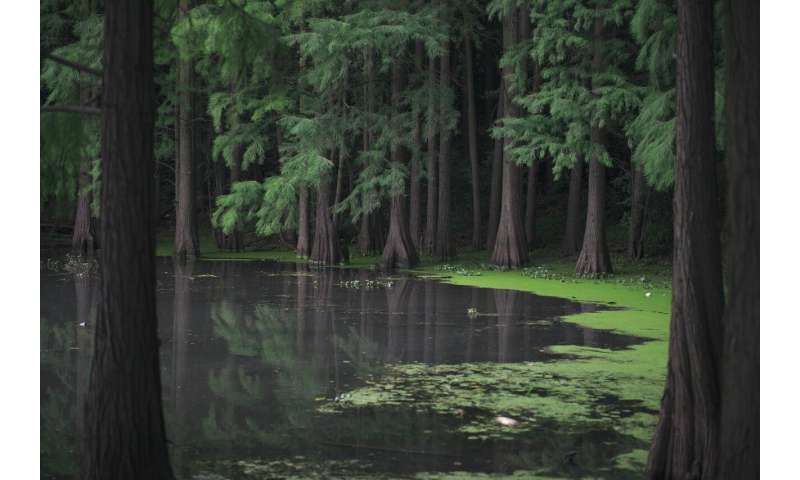 AUSTRALIA - Healthy mangroves can help fight the consequences of climate change on coral reef fisheries, according to a University of Queensland-led study. UQ's Professor Peter Mumby said corals have been bleached and reefs have lost their structural complexity as a major consequence of warming seas. "Many people are worried that—due to climate change—reef fishery yields could halve if coral reefs flatten, losing the hiding places that support thousands of fish," he said. "When a young fish arrives at a degraded reef it has nowhere to hide and is easily targeted by predators. "Of course, predators experience the same problem when they're young, so the entire food web becomes unproductive and few fish survive." Despite the alarming trend, the team found mangroves provided a partial solution. "We know that many reef fish can use mangroves as an alternative nursery habitat to the reef," Professor Mumby said. "Mangroves provide a calm, safe environment with plenty of food and allow fish to grow larger before heading out to the reef as adults. READ MORE LAST WORD Great Gift For The Holidays MAP's 2020 Children's Art Calendars are now available. These make great gifts to show your support of global climate efforts and are a helpful reminder for what we can do to assist in saving our world’s mangroves. Use the donation form below to select your calendar order, and receive a tax-deductible receipt for doing so – thank you! (Note: All costs include the cost of shipping – please select whether you will be shipping to a US or International address for according pricing. 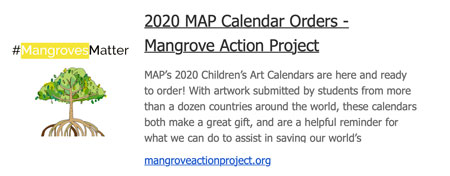 CLICK HERE |
CHILDREN'S ART CALENDAR - A great way to show your support for MAP. NOW TAKING ORDERS for our 2020 calendar
|
|
Mangrove Action Project Click here to view past newsletters
|
|
-
The community of adults and youth in Cayman Islands has come together recently to release a series of educational videos. Each is geared to...
-
By Alfredo Quarto, Program & Policy Director Co-founder, MAP There is a rather urgent situation concerning the bio-invasion of the Son...
-
By: Isabel Robinson, MAP Volunteer Intern Some months ago I decided to come to Thailand and do an internship in mangrove conservation, ...
MAP News Issue #596 = April 20, 2024
ENTRIES NOW OPEN! Mangrove Photography Awards 2024 10 Years Celebrating Mangroves GLOBAL - MAP has launched our 10th Mangrove Photograp...



